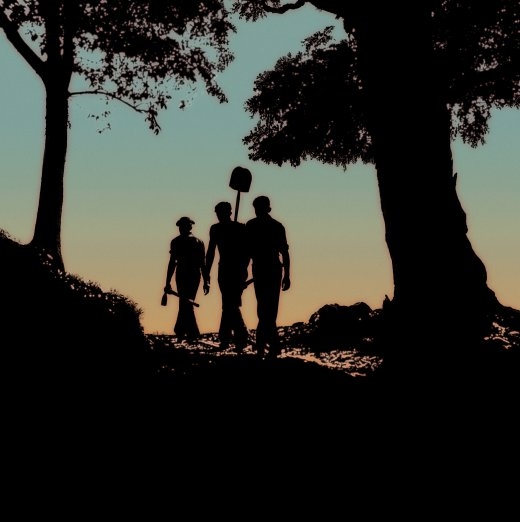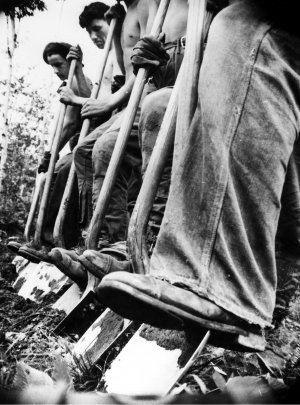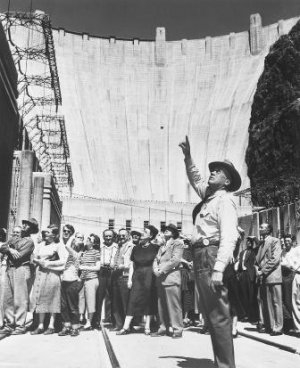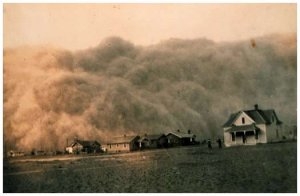
The 1930s collection examines America’s response to the unprecedented economic crisis that threatened the nation during one of history’s most tumultuous decades — a decade that is increasingly a touchstone for our own. In a series of five films, this AMERICAN EXPERIENCE explores politics and culture during the Great Depression through eyewitness accounts and rare archival footage. The 1930s (which will air locally on WHYY TV starting tonight at 9 PM and runs for the next five Monday nights) touches on themes straight from the 2009 news headlines — beginning with the problems with banking security, stock market manipulation, and speculation that led to the Crash of 1929 and the subsequent Great Depression.
In 1933, newly-elected President Franklin D. Roosevelt launched an unprecedented economic stimulus package as part of what he called the New Deal. One of the most popular New Deal programs, The Civilian Conservation Corps, put young men to work for $1 a day. Two months later, thousands of skilled workers began construction on Hoover  Dam, one of the greatest engineering projects of the modern era. Meanwhile, farmers and residents of the Great Plains suffered through a catastrophic eight-year drought in Surviving the Dust Bowl. Finally, Depression-wary Americans found an unlikely hero in a champion Thoroughbred horse named Seabiscuit. “The past offers us the opportunity to see the shape of human experience,” says AMERICAN EXPERIENCE executive producer Mark Samels. “As we navigate through our current global recession, the likes of which we haven’t seen in more than 75 years, Americans can look to the ’30s to help understand how we got here, and where we may end up next.”
Dam, one of the greatest engineering projects of the modern era. Meanwhile, farmers and residents of the Great Plains suffered through a catastrophic eight-year drought in Surviving the Dust Bowl. Finally, Depression-wary Americans found an unlikely hero in a champion Thoroughbred horse named Seabiscuit. “The past offers us the opportunity to see the shape of human experience,” says AMERICAN EXPERIENCE executive producer Mark Samels. “As we navigate through our current global recession, the likes of which we haven’t seen in more than 75 years, Americans can look to the ’30s to help understand how we got here, and where we may end up next.”
Samels was named to lead PBS’s flagship history series, AMERICAN EXPERIENCE, in 2003 after serving as senior producer since 1997. Produced by WGBH/Boston, AMERICAN EXPERIENCE is television’s most-watched and longest running history series, and the recipient of every major industry award, including the Peabody, Primetime Emmy, Writers Guild and duPont-Columbia Journalism Award. Recently we got Samels on the horn and asked him to explain the series.
PHAWKER: First of all, can you thumbnail what the series is all about and what the motivation was behind creating it?
 MARK SAMELS: The 1930’s is a mini-series within American Experience on PBS. Certainly after the election of Obama last year, a lot of comparisons were beginning to be drawn between the 1930’s and our current administration. With the financial crisis and everything people started talking about the similarities when Franklin Roosevelt took over. We got to thinking we have such a strong series of films we made about the 1930’s that we never really brought together as a collection, and if we produced a new program we could have a really nice well-rounded collection of shows that I think would open discussions into our gaps of understanding about the present by looking back at the lessons that the 1930’s offer. They’re not identical because history doesn’t necessarily repeat itself, but there’s some embedded lessons about how this country responded to crisis; looking back we had economical crisis, environmental crisis, and I thought it would be valuable to open discussion on our current situation.
MARK SAMELS: The 1930’s is a mini-series within American Experience on PBS. Certainly after the election of Obama last year, a lot of comparisons were beginning to be drawn between the 1930’s and our current administration. With the financial crisis and everything people started talking about the similarities when Franklin Roosevelt took over. We got to thinking we have such a strong series of films we made about the 1930’s that we never really brought together as a collection, and if we produced a new program we could have a really nice well-rounded collection of shows that I think would open discussions into our gaps of understanding about the present by looking back at the lessons that the 1930’s offer. They’re not identical because history doesn’t necessarily repeat itself, but there’s some embedded lessons about how this country responded to crisis; looking back we had economical crisis, environmental crisis, and I thought it would be valuable to open discussion on our current situation.
PHAWKER: The series is going to run on five succeeding Mondays, so I thought we could go through each of the episodes and speak to what you see as each one’s modern analog, the first one being The Crash of 1929
MARK SAMELS: It’s a bit odd to be doing a series on the 1930’s and having an episode on 1929, but the 30’s began, in a big way, with the stock market crash in October, 1929. We have a program about that that looks back at this boom, the roaring 20’s when income was skyrocketing. There were bubbles of all sorts in real estate, investments, and stock markets. Sounds a lot like what’s happened in the last six or seven years leading up to our own crash last fall. This kinda gets things flowing, but it just shows the 1920’s as being eerily similar to the first decade of the 21st century.
PHAWKER: The next episode is the Civilian Conservation Core.
MARK SAMELS: That’s a new production that we just put in the works in March. What attracted me to that topic was the New Deal that  Roosevelt ushered in in dramatic fashion in the first hundred days of his administration, with remarkable speed and tremendous impact over the long term. By far one of the most popular programs was the Civilian Conservation Corps. It was put into law within a week and within a month 25,000 young men signed up to be part of the Corps. By the time the program had run its course 10 years later, somewhere around four million men had signed up. It was a direct relief program for millions of American families. Secondly, it came about at a time when the U.S. environment was in really bad shape. Farms were dealing with years of erosion. There were a tremendous number of problems with the land in America that Roosevelt knew firsthand from his experience. First he dealt with the land problems in America and it wasn’t until later that he started building the lodges and bridges and national parks that we now use. I can tell you that if you’re taking a hike in a national or state park you’ve probably walked over ground that the CCC has cleared. If you’ve driven by fields in the Great Plains they’re housing and producing corn now because in the 1930’s they were repaired by the CCC. The crisis we have now with global warming, there was a similar crisis in the 1930’s.
Roosevelt ushered in in dramatic fashion in the first hundred days of his administration, with remarkable speed and tremendous impact over the long term. By far one of the most popular programs was the Civilian Conservation Corps. It was put into law within a week and within a month 25,000 young men signed up to be part of the Corps. By the time the program had run its course 10 years later, somewhere around four million men had signed up. It was a direct relief program for millions of American families. Secondly, it came about at a time when the U.S. environment was in really bad shape. Farms were dealing with years of erosion. There were a tremendous number of problems with the land in America that Roosevelt knew firsthand from his experience. First he dealt with the land problems in America and it wasn’t until later that he started building the lodges and bridges and national parks that we now use. I can tell you that if you’re taking a hike in a national or state park you’ve probably walked over ground that the CCC has cleared. If you’ve driven by fields in the Great Plains they’re housing and producing corn now because in the 1930’s they were repaired by the CCC. The crisis we have now with global warming, there was a similar crisis in the 1930’s.
PHAWKER: Next episode, Hoover Dam.
MARK SAMELS: Hoover Dam is an interesting mash of public works projects. It was operated sort of quasi private public concern; the damming was later seen as environmentally intrusive. Again though, it came at a time when jobs were just non-existent. Today, we’re experiencing 10% direct unemployment, probably another 5-10% people who have given up looking for jobs. It’s very difficult today, but in the 1930’s, unemployment never fell below 25%; it was actually much higher most of the time. It’s hard to exaggerate the bleak job picture for most working Americans, and here was this big project out building this massive dam. It was dangerous work; let’s face it, there was going to be one of the mightiest rivers in the world. It sort of represented a high point of American industrial spirit and our relationship to teeming nature which later came to be questioned by many. It’s a multi-dimensional story of larger than life workers hanging over the side and this big project during the depression
 PHAWKER: Next up, Surviving the Dustbowl
PHAWKER: Next up, Surviving the Dustbowl
MARK SAMELS: This program takes up the theme that the CCC lays down. By the early 1930’s so much of the land in the U.S. was in such bad shape that it really materialized in the form of these massive dust clouds that kicked up this eroded soil in the Great Plains. As one of the guys in the CCC film says, he was sitting in North Carolina and he looked up and watched Kansas go by. That’s more or less what it was like. This really focuses on the human dimension; the families who were living primarily out in Texas, Kansas, Nebraska, the Dakotas, and the Great Plains. During the 1930’s their livelihood literally blew away. Their houses were gone, their farms were no longer productive, and they just scrambled to get by. Many people made famous The Grapes of Wrath, picked up and went to the promised land of California. Many stayed and tried to to figure out how they could survive in this environmental catastrophe. Very dramatic story.
PHAWKER: And finally, Seabiscuit.
MARK SAMELS: Well, Seabiscuit is a nice compliment to the struggles and tribunals of the 1930’s. In the midst of all these problems and all  the crises surrounding them, there was this story that emerged from the most unlikely place; on the racetrack. There was this ungainly not very impressive looking race horse with the unlikely name of Seabiscuit captivated America and really worked its way into their hearts. He began racking up victory after victory to become one of the greatest race horses in history. He went up against the prince of race horses in the 1930’s and managed to beat him. It’s a story of the underdog, which is kind of the archetypal story in American culture. It came to life in the form of the trainer who had an on again, off again career, the owner was a gambler and a ne’er do well, this jockey who was almost killed in the few weeks before a big race and bounce around the race track for years not amounting to much, and his unlikely horse who was smaller and uglier than anything else on the track who managed to win. It became, in a way, a symbol for many people for perseverance, resilience, and the idea that Americans could pull through in the 1930’s.
the crises surrounding them, there was this story that emerged from the most unlikely place; on the racetrack. There was this ungainly not very impressive looking race horse with the unlikely name of Seabiscuit captivated America and really worked its way into their hearts. He began racking up victory after victory to become one of the greatest race horses in history. He went up against the prince of race horses in the 1930’s and managed to beat him. It’s a story of the underdog, which is kind of the archetypal story in American culture. It came to life in the form of the trainer who had an on again, off again career, the owner was a gambler and a ne’er do well, this jockey who was almost killed in the few weeks before a big race and bounce around the race track for years not amounting to much, and his unlikely horse who was smaller and uglier than anything else on the track who managed to win. It became, in a way, a symbol for many people for perseverance, resilience, and the idea that Americans could pull through in the 1930’s.
PHAWKER: Now here’s where you say something inspirational along the lines of those who ignore history are doomed to repeat it.
MARK SAMELS: Well, I actually shy away from the cliches of our history, but there’s one thing that makes history always worth looking at, and that’s enduring tremendous lessons as well as captivating stories. For me, one of the great legends of history is this sense of humility that people who have come before us have faced difficulties. There’s a comfort in there that people before us have met and overcome obstacles that, looking in our uncertain future, seem overwhelming to people. There’s actually a book of lessons that nestles that comfort, and that’s what we try to do every week on American Experience; try to look at those stories and find out who we are as people, try to see the unrealized aspirations of the American experiment. That’s what The 1930’s is all about. We went through one of the weakest moments in American history, we pulled through, and we came out of it.
The 1930s will air locally on WHYY TV starting tonight at 9 PM and runs for the next five Monday nights

RELATED: First Person Arts is marking the 80-year anniversary of the stock market crash with a one-night, cultural journey back to the 1930s. On Wednesday, November 4, First Person Festival audiences will experience the art and entertainment that brightened peoples lives during those dark times. First Person Arts will kick-off the evening with the opening of the Festival Speakeasy, recreating the electric atmosphere of the prohibition era, with an open bar and private lounge. Following the reception, guests will gather for America Eats! — a family-style buffet with recollections of depression-era food traditions, hosted by author, Pat Willard. The highlight of the evening will be a concert of Songs for Any Depression, featuring the songs of Woody Guthrie performed by his granddaughter Sarah Lee and her husband Johnny Irion, along with other selections by folk duo Kim and Reggie Harris. MORE
